Kexue Fu
CurriFlow: Curriculum-Guided Depth Fusion with Optical Flow-Based Temporal Alignment for 3D Semantic Scene Completion
Oct 14, 2025Abstract:Semantic Scene Completion (SSC) aims to infer complete 3D geometry and semantics from monocular images, serving as a crucial capability for camera-based perception in autonomous driving. However, existing SSC methods relying on temporal stacking or depth projection often lack explicit motion reasoning and struggle with occlusions and noisy depth supervision. We propose CurriFlow, a novel semantic occupancy prediction framework that integrates optical flow-based temporal alignment with curriculum-guided depth fusion. CurriFlow employs a multi-level fusion strategy to align segmentation, visual, and depth features across frames using pre-trained optical flow, thereby improving temporal consistency and dynamic object understanding. To enhance geometric robustness, a curriculum learning mechanism progressively transitions from sparse yet accurate LiDAR depth to dense but noisy stereo depth during training, ensuring stable optimization and seamless adaptation to real-world deployment. Furthermore, semantic priors from the Segment Anything Model (SAM) provide category-agnostic supervision, strengthening voxel-level semantic learning and spatial consistency. Experiments on the SemanticKITTI benchmark demonstrate that CurriFlow achieves state-of-the-art performance with a mean IoU of 16.9, validating the effectiveness of our motion-guided and curriculum-aware design for camera-based 3D semantic scene completion.
A Constructed Response: Designing and Choreographing Robot Arm Movements in Collaborative Dance Improvisation
May 29, 2025Abstract:Dancers often prototype movements themselves or with each other during improvisation and choreography. How are these interactions altered when physically manipulable technologies are introduced into the creative process? To understand how dancers design and improvise movements while working with instruments capable of non-humanoid movements, we engaged dancers in workshops to co-create movements with a robot arm in one-human-to-one-robot and three-human-to-one-robot settings. We found that dancers produced more fluid movements in one-to-one scenarios, experiencing a stronger sense of connection and presence with the robot as a co-dancer. In three-to-one scenarios, the dancers divided their attention between the human dancers and the robot, resulting in increased perceived use of space and more stop-and-go movements, perceiving the robot as part of the stage background. This work highlights how technologies can drive creativity in movement artists adapting to new ways of working with physical instruments, contributing design insights supporting artistic collaborations with non-humanoid agents.
LEAM: A Prompt-only Large Language Model-enabled Antenna Modeling Method
Apr 25, 2025Abstract:Antenna modeling is a time-consuming and complex process, decreasing the speed of antenna analysis and design. In this paper, a large language model (LLM)- enabled antenna modeling method, called LEAM, is presented to address this challenge. LEAM enables automatic antenna model generation based on language descriptions via prompt input, images, descriptions from academic papers, patents, and technical reports (either one or multiple). The effectiveness of LEAM is demonstrated by three examples: a Vivaldi antenna generated from a complete user description, a slotted patch antenna generated from an incomplete user description and the operating frequency, and a monopole slotted antenna generated from images and descriptions scanned from the literature. For all the examples, correct antenna models are generated in a few minutes. The code can be accessed via https://github.com/TaoWu974/LEAM.
Focus on Local: Finding Reliable Discriminative Regions for Visual Place Recognition
Apr 14, 2025Abstract:Visual Place Recognition (VPR) is aimed at predicting the location of a query image by referencing a database of geotagged images. For VPR task, often fewer discriminative local regions in an image produce important effects while mundane background regions do not contribute or even cause perceptual aliasing because of easy overlap. However, existing methods lack precisely modeling and full exploitation of these discriminative regions. In this paper, we propose the Focus on Local (FoL) approach to stimulate the performance of image retrieval and re-ranking in VPR simultaneously by mining and exploiting reliable discriminative local regions in images and introducing pseudo-correlation supervision. First, we design two losses, Extraction-Aggregation Spatial Alignment Loss (SAL) and Foreground-Background Contrast Enhancement Loss (CEL), to explicitly model reliable discriminative local regions and use them to guide the generation of global representations and efficient re-ranking. Second, we introduce a weakly-supervised local feature training strategy based on pseudo-correspondences obtained from aggregating global features to alleviate the lack of local correspondences ground truth for the VPR task. Third, we suggest an efficient re-ranking pipeline that is efficiently and precisely based on discriminative region guidance. Finally, experimental results show that our FoL achieves the state-of-the-art on multiple VPR benchmarks in both image retrieval and re-ranking stages and also significantly outperforms existing two-stage VPR methods in terms of computational efficiency. Code and models are available at https://github.com/chenshunpeng/FoL
Exploring CLIP's Dense Knowledge for Weakly Supervised Semantic Segmentation
Mar 26, 2025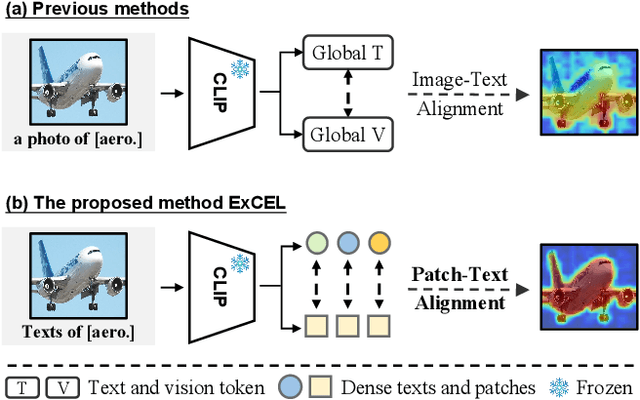


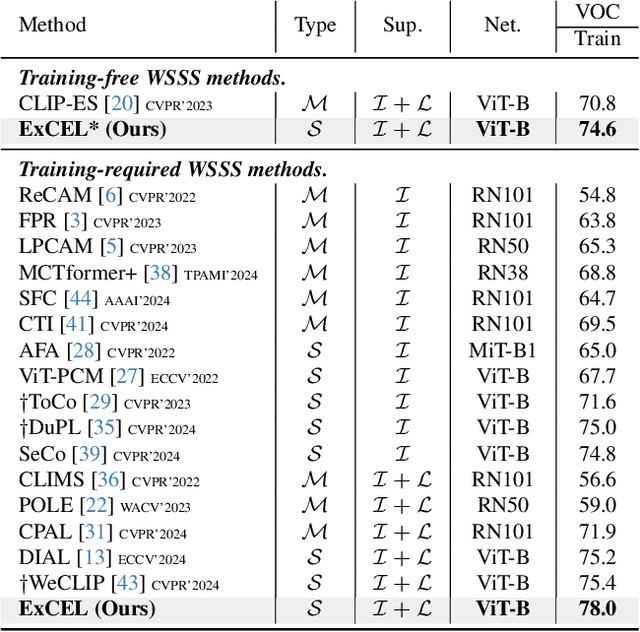
Abstract:Weakly Supervised Semantic Segmentation (WSSS) with image-level labels aims to achieve pixel-level predictions using Class Activation Maps (CAMs). Recently, Contrastive Language-Image Pre-training (CLIP) has been introduced in WSSS. However, recent methods primarily focus on image-text alignment for CAM generation, while CLIP's potential in patch-text alignment remains unexplored. In this work, we propose ExCEL to explore CLIP's dense knowledge via a novel patch-text alignment paradigm for WSSS. Specifically, we propose Text Semantic Enrichment (TSE) and Visual Calibration (VC) modules to improve the dense alignment across both text and vision modalities. To make text embeddings semantically informative, our TSE module applies Large Language Models (LLMs) to build a dataset-wide knowledge base and enriches the text representations with an implicit attribute-hunting process. To mine fine-grained knowledge from visual features, our VC module first proposes Static Visual Calibration (SVC) to propagate fine-grained knowledge in a non-parametric manner. Then Learnable Visual Calibration (LVC) is further proposed to dynamically shift the frozen features towards distributions with diverse semantics. With these enhancements, ExCEL not only retains CLIP's training-free advantages but also significantly outperforms other state-of-the-art methods with much less training cost on PASCAL VOC and MS COCO.
MoRe: Class Patch Attention Needs Regularization for Weakly Supervised Semantic Segmentation
Dec 15, 2024



Abstract:Weakly Supervised Semantic Segmentation (WSSS) with image-level labels typically uses Class Activation Maps (CAM) to achieve dense predictions. Recently, Vision Transformer (ViT) has provided an alternative to generate localization maps from class-patch attention. However, due to insufficient constraints on modeling such attention, we observe that the Localization Attention Maps (LAM) often struggle with the artifact issue, i.e., patch regions with minimal semantic relevance are falsely activated by class tokens. In this work, we propose MoRe to address this issue and further explore the potential of LAM. Our findings suggest that imposing additional regularization on class-patch attention is necessary. To this end, we first view the attention as a novel directed graph and propose the Graph Category Representation module to implicitly regularize the interaction among class-patch entities. It ensures that class tokens dynamically condense the related patch information and suppress unrelated artifacts at a graph level. Second, motivated by the observation that CAM from classification weights maintains smooth localization of objects, we devise the Localization-informed Regularization module to explicitly regularize the class-patch attention. It directly mines the token relations from CAM and further supervises the consistency between class and patch tokens in a learnable manner. Extensive experiments are conducted on PASCAL VOC and MS COCO, validating that MoRe effectively addresses the artifact issue and achieves state-of-the-art performance, surpassing recent single-stage and even multi-stage methods. Code is available at https://github.com/zwyang6/MoRe.
FAST: A Dual-tier Few-Shot Learning Paradigm for Whole Slide Image Classification
Sep 29, 2024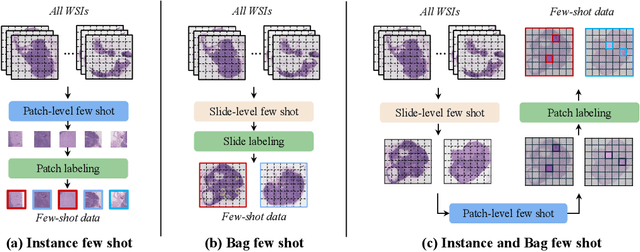
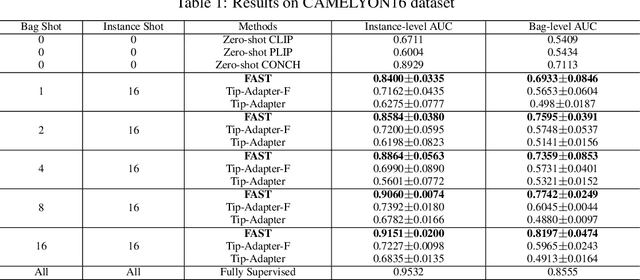
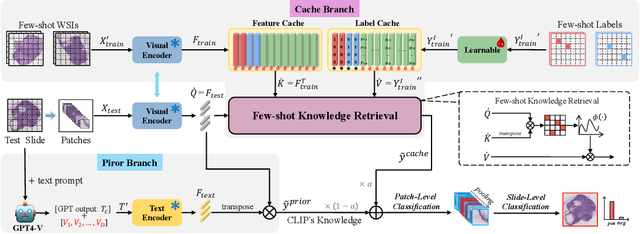
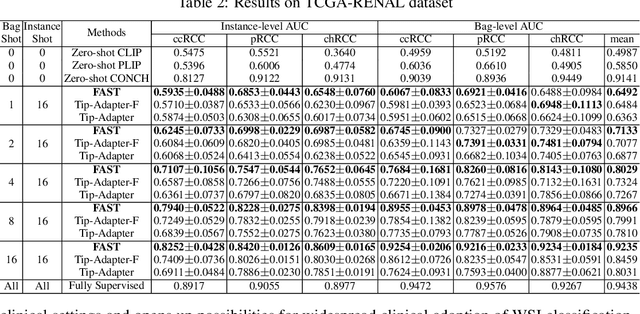
Abstract:The expensive fine-grained annotation and data scarcity have become the primary obstacles for the widespread adoption of deep learning-based Whole Slide Images (WSI) classification algorithms in clinical practice. Unlike few-shot learning methods in natural images that can leverage the labels of each image, existing few-shot WSI classification methods only utilize a small number of fine-grained labels or weakly supervised slide labels for training in order to avoid expensive fine-grained annotation. They lack sufficient mining of available WSIs, severely limiting WSI classification performance. To address the above issues, we propose a novel and efficient dual-tier few-shot learning paradigm for WSI classification, named FAST. FAST consists of a dual-level annotation strategy and a dual-branch classification framework. Firstly, to avoid expensive fine-grained annotation, we collect a very small number of WSIs at the slide level, and annotate an extremely small number of patches. Then, to fully mining the available WSIs, we use all the patches and available patch labels to build a cache branch, which utilizes the labeled patches to learn the labels of unlabeled patches and through knowledge retrieval for patch classification. In addition to the cache branch, we also construct a prior branch that includes learnable prompt vectors, using the text encoder of visual-language models for patch classification. Finally, we integrate the results from both branches to achieve WSI classification. Extensive experiments on binary and multi-class datasets demonstrate that our proposed method significantly surpasses existing few-shot classification methods and approaches the accuracy of fully supervised methods with only 0.22$\%$ annotation costs. All codes and models will be publicly available on https://github.com/fukexue/FAST.
Tackling Ambiguity from Perspective of Uncertainty Inference and Affinity Diversification for Weakly Supervised Semantic Segmentation
Apr 12, 2024Abstract:Weakly supervised semantic segmentation (WSSS) with image-level labels intends to achieve dense tasks without laborious annotations. However, due to the ambiguous contexts and fuzzy regions, the performance of WSSS, especially the stages of generating Class Activation Maps (CAMs) and refining pseudo masks, widely suffers from ambiguity while being barely noticed by previous literature. In this work, we propose UniA, a unified single-staged WSSS framework, to efficiently tackle this issue from the perspective of uncertainty inference and affinity diversification, respectively. When activating class objects, we argue that the false activation stems from the bias to the ambiguous regions during the feature extraction. Therefore, we design a more robust feature representation with a probabilistic Gaussian distribution and introduce the uncertainty estimation to avoid the bias. A distribution loss is particularly proposed to supervise the process, which effectively captures the ambiguity and models the complex dependencies among features. When refining pseudo labels, we observe that the affinity from the prevailing refinement methods intends to be similar among ambiguities. To this end, an affinity diversification module is proposed to promote diversity among semantics. A mutual complementing refinement is proposed to initially rectify the ambiguous affinity with multiple inferred pseudo labels. More importantly, a contrastive affinity loss is further designed to diversify the relations among unrelated semantics, which reliably propagates the diversity into the whole feature representations and helps generate better pseudo masks. Extensive experiments are conducted on PASCAL VOC, MS COCO, and medical ACDC datasets, which validate the efficiency of UniA tackling ambiguity and the superiority over recent single-staged or even most multi-staged competitors.
Separate and Conquer: Decoupling Co-occurrence via Decomposition and Representation for Weakly Supervised Semantic Segmentation
Feb 29, 2024



Abstract:Attributed to the frequent coupling of co-occurring objects and the limited supervision from image-level labels, the challenging co-occurrence problem is widely present and leads to false activation of objects in weakly supervised semantic segmentation (WSSS). In this work, we devise a 'Separate and Conquer' scheme SeCo to tackle this issue from dimensions of image space and feature space. In the image space, we propose to 'separate' the co-occurring objects with image decomposition by subdividing images into patches. Importantly, we assign each patch a category tag from Class Activation Maps (CAMs), which spatially helps remove the co-context bias and guide the subsequent representation. In the feature space, we propose to 'conquer' the false activation by enhancing semantic representation with multi-granularity knowledge contrast. To this end, a dual-teacher-single-student architecture is designed and tag-guided contrast is conducted to guarantee the correctness of knowledge and further facilitate the discrepancy among co-occurring objects. We streamline the multi-staged WSSS pipeline end-to-end and tackle co-occurrence without external supervision. Extensive experiments are conducted, validating the efficiency of our method tackling co-occurrence and the superiority over previous single-staged and even multi-staged competitors on PASCAL VOC and MS COCO. Code will be available at https://github.com/zwyang6/SeCo.git.
PointMBF: A Multi-scale Bidirectional Fusion Network for Unsupervised RGB-D Point Cloud Registration
Aug 09, 2023Abstract:Point cloud registration is a task to estimate the rigid transformation between two unaligned scans, which plays an important role in many computer vision applications. Previous learning-based works commonly focus on supervised registration, which have limitations in practice. Recently, with the advance of inexpensive RGB-D sensors, several learning-based works utilize RGB-D data to achieve unsupervised registration. However, most of existing unsupervised methods follow a cascaded design or fuse RGB-D data in a unidirectional manner, which do not fully exploit the complementary information in the RGB-D data. To leverage the complementary information more effectively, we propose a network implementing multi-scale bidirectional fusion between RGB images and point clouds generated from depth images. By bidirectionally fusing visual and geometric features in multi-scales, more distinctive deep features for correspondence estimation can be obtained, making our registration more accurate. Extensive experiments on ScanNet and 3DMatch demonstrate that our method achieves new state-of-the-art performance. Code will be released at https://github.com/phdymz/PointMBF
 Add to Chrome
Add to Chrome Add to Firefox
Add to Firefox Add to Edge
Add to Edge